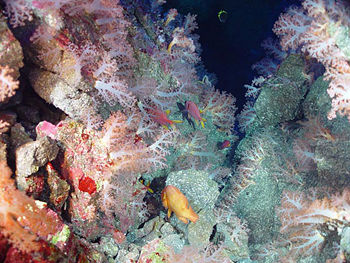Aquarium Niche

]
An aquarium is an artificial ecosystem that is inhabitable by various aquatic species. The environment of the aquarium can differ depending on the residing species. For example, Xiphophorus helleri or Green Swordtail prefer to live in freshwater, while Paracanthurus hepatus or Surgeonfish prefer water with higher salt concentration [2]. Aquarist must maintain specific pH, temperature levels, and lighting for different species in the aquarium. Salinity, the concentration of salt in a given amount of water, becomes one of the characteristics to distinguish between the different types of aquariums. Salinity can be measured using a hydrometer, which compares the specific gravity of sample with pure water under the units of ppt (parts per thousand) or ppm (parts per million) [2]. In addition, the aquarium's hardness must be monitored. The levels of dissolved minerals, such as bicarbonates, in water is described as the water's "hardness" [2].
Nothing quite adds to the room décor as adding an aquarium with beautifully colored fishes with lively aquatic plants. However, what keeps these colorful organisms alive and healthy are none other than the series of micro-organisms, also known as microbes.
Types of Aquarium Niche
Commercial aquariums come in variety of shapes and sizes, from tiny one gallon fish bowls to luxurious 100 gallon fish tanks, and normally can be set simply on a desk top or on top of a special aquarium stand. There are generally four types of aquariums a new aquarist can set up: tropical freshwater, cold freshwater, brackish, and saltwater. Each type of aquarium requires specific care and maintenance, and different types of fish reside in each of the designed ecosystem.
Tropical Freshwater Aquarium
In tropical freshwater aquariums for fish such as tetras and gouramis, the temperature must be kept at 72 - 80 °F (22 -27 °C). The pH must be kept between 6 and 8, the stability and the consistency of the pH also playing an important role in ensuring the health of the fish. Since freshwater fish normally cannot tolerate any salinity, salinity must be kept under 3ppm (parts per million).
Cold Freshwater Aquarium
In cold freshwater aquariums for fish such as goldfish and koi, the temperature should be kept typically below 70 °F (20 °C). The light should be kept at the standard level and the hardness of the water at 100-200mg/L CaCO3.
Brackish Water Aquarium
Brackish water aquarium is an artificial ecosystem that simulates the natural environment of brackish water, which has a salt concentration between freshwater and saltwater. Brackish water aquarium is kept at a temperature around 23-29°C, with a pH between 7 to 8, a hardness of 200 mg/liter of CaCO3, a specific gravity of 1.003-1.012, and a salinity between 7.6 and 14 ppt [2].
The brackish water can be found in an estuary, a body of water where freshwater from the stream meets the open sea [2]. The salinity of the water varies from 1 ppt to 36 ppt due to the interactions between freshwater and saltwater. For example, salinity of the estuary can be affected by freshwater from the rain or the river [2]. Bacteria used in filtration, such as Nitrosomonas and Nitrobacter, cannot tolerate these changes; hence, in the aquarium, it is normal to have a stable salinity level [3].
Brackwish water can be found in Central American costal streams, East Africa mangrove swamps, and Southeast Asia estuaries [2]. A large variety of species inhabit the brackish water, such as Sailfin, Monos, Scats, Archerfisher, Pufferfish, and Cichlids [3]. Planting in Brackish water aquarium is difficult because there are limited number of brackish water tolerant plants being distributed. This includes Microsorium pteropus, Crinum calamistratum, Lilaeopsis brasiliensis, Bacopa monnieri, and Cryptocoryne ciliata [3]. However, some freshwater plants can adapt to the salinity of the brackish water, including Vallisneria gigantea, Anubias barteri, Hygrophila polysperma, Ceratophyllum demersum, Crinum thaianum, and Cryptocoryne wendtii [3].
Saltwater Aquarium
Influence by Adjacent Communities (if any)
Is your niche close to another niche or influenced by another community of organisms?
Conditions under which the environment changes
Do any of the physical conditions change? Are there chemicals, other organisms, nutrients, etc. that might change the community of your niche.
Who lives there?
Which microbes are present?
You may refer to organisms by genus or by genus and species, depending upon how detailed the your information might be. If there is already a microbewiki page describing that organism, make a link to it.
Are there any other non-microbes present?
Plants? Animals? Fungi? etc.
Do the microbes that are present interact with each other?
Describe any negative (competition) or positive (symbiosis) behavior
Do the microbes change their environment?
Do they alter pH, attach to surfaces, secrete anything, etc. etc.
Do the microbes carry out any metabolism that affects their environment?
Do they ferment sugars to produce acid, break down large molecules, fix nitrogen, etc. etc.
'Super' bacteria live on sheets, fingernails: study
On June 6, 2005, U.S reserachers
References
- "aquarium_600.jpg". NOAA: Ocean Explorer. 26 August 2008. <http://oceanexplorer.noaa.gov/explorations/04fire/logs/april05/media/aquarium.html>.
- Scott, Peter W. The Complete Aquarium. New York: Alfred A. Knopf Inc., 1991.
- Monks, Neale. Brackish FAQ. 2007. 20 August 2008. <http://homepage.mac.com/nmonks/Projects/brackishfaq.html>.
- "p25%20Mangrove%20community.jpg". A Tour of China in Winter: Part 4b, A Visit to the Shanghai Ocean. Aquarticles. 25 August 2008. <http://www.aquarticles.com/articles/travel/Norfolk_4bChina_Shanghai_Aquarium.html>.

